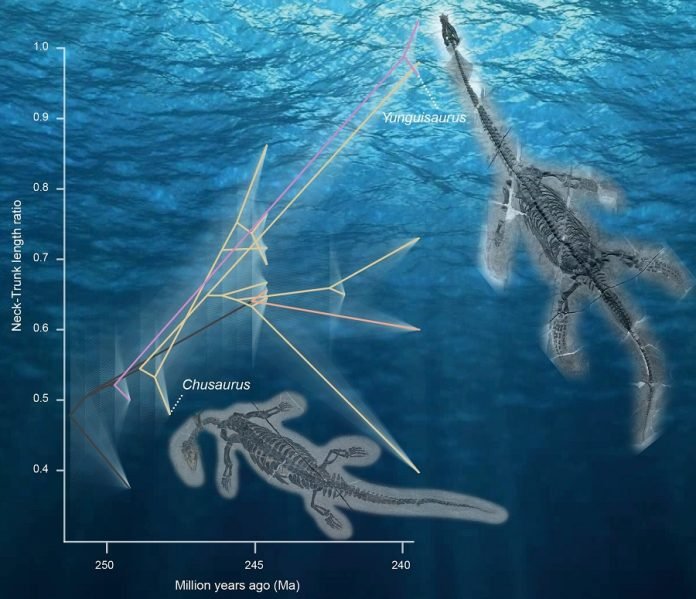
Ever wonder how some dinosaurs got really long necks?
Imagine a marine reptile, like the plesiosaur, with a neck five times longer than its body!
Scientists have found out how this happened and it’s like something straight from a dinosaur movie.
First, let’s talk about plesiosaurs. These were ancient reptiles that lived in the ocean about 250 million years ago. They had super-long necks that they probably used to quickly catch fish.
Now, researchers from China and the UK have discovered how these long necks came to be.
And guess what? They didn’t take too long to develop; it all happened in just five million years!
So, how did scientists figure this out? They found two complete skeletons of a new type of reptile called Chusaurus xiangensis in China.
This little guy is important because it’s an ancestor to plesiosaurs and helps us understand how they evolved. Even though Chusaurus had a short neck compared to its later relatives, it was the beginning of something big.
Qi-Ling Liu from the China University of Geosciences in Wuhan led the project and was super excited to find this “new beast.”
It’s small, less than half a meter long, but it’s a big deal for understanding an important group of marine reptiles called Sauropterygia.
Now here comes the interesting part. Normally, animals like us, reptiles, and mammals, have seven bones in our necks. But these ancient creatures added more and more bones to make their necks longer.
Chusaurus started with 17 neck bones, and as time went on, some plesiosaurs had as many as 72! That’s like having a snake for a neck!
Professor Michael Benton from the University of Bristol explained that this fast evolution happened right after a big disaster called the end-Permian mass extinction. This terrible event wiped out nearly 90% of all life on Earth.
But for the survivors, it was like a new beginning, especially for these marine reptiles who had to adapt quickly.
But why did they need such long necks? Scientists think these long-necked reptiles were small predators feeding on shrimps and small fish.
Their long necks helped them sneak up on schools of fish and quickly catch them. It’s like having a built-in fishing rod!
However, Dr. Ben Moon from the University of Bristol added that these plesiosaurs probably reached a “perfect neck length” for their way of life.
Having an extremely long neck might have come with its own problems, like being hard to move or requiring more energy. So, the neck length stabilized at a point that was just right for catching their prey.
This exciting discovery helps us understand how nature works in mysterious ways, especially after big changes like mass extinctions.
It shows us that animals can adapt quickly and in really fascinating ways, just like the plesiosaurs did with their amazing necks!
Follow us on Twitter for more articles about this topic.



